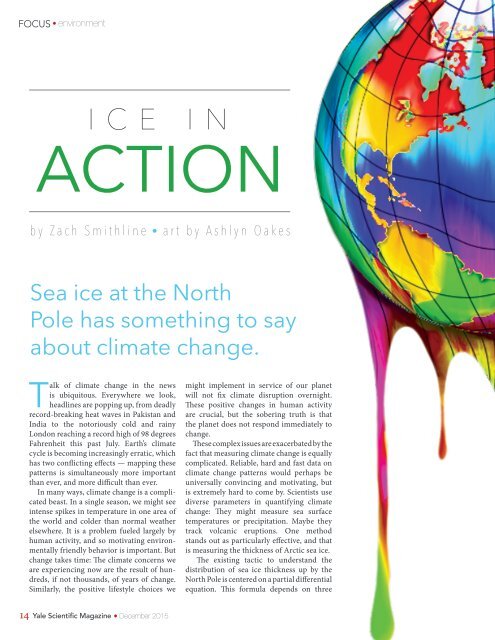YSM Issue 89.1
Create successful ePaper yourself
Turn your PDF publications into a flip-book with our unique Google optimized e-Paper software.
FOCUS<br />
environment<br />
ICE IN<br />
ACTION<br />
by Zach Smithline<br />
art by Ashlyn Oakes<br />
Sea ice at the North<br />
Pole has something to say<br />
about climate change.<br />
Talk of climate change in the news<br />
is ubiquitous. Everywhere we look,<br />
headlines are popping up, from deadly<br />
record-breaking heat waves in Pakistan and<br />
India to the notoriously cold and rainy<br />
London reaching a record high of 98 degrees<br />
Fahrenheit this past July. Earth’s climate<br />
cycle is becoming increasingly erratic, which<br />
has two conflicting effects — mapping these<br />
patterns is simultaneously more important<br />
than ever, and more difficult than ever.<br />
In many ways, climate change is a complicated<br />
beast. In a single season, we might see<br />
intense spikes in temperature in one area of<br />
the world and colder than normal weather<br />
elsewhere. It is a problem fueled largely by<br />
human activity, and so motivating environmentally<br />
friendly behavior is important. But<br />
change takes time: The climate concerns we<br />
are experiencing now are the result of hundreds,<br />
if not thousands, of years of change.<br />
Similarly, the positive lifestyle choices we<br />
might implement in service of our planet<br />
will not fix climate disruption overnight.<br />
These positive changes in human activity<br />
are crucial, but the sobering truth is that<br />
the planet does not respond immediately to<br />
change.<br />
These complex issues are exacerbated by the<br />
fact that measuring climate change is equally<br />
complicated. Reliable, hard and fast data on<br />
climate change patterns would perhaps be<br />
universally convincing and motivating, but<br />
is extremely hard to come by. Scientists use<br />
diverse parameters in quantifying climate<br />
change: They might measure sea surface<br />
temperatures or precipitation. Maybe they<br />
track volcanic eruptions. One method<br />
stands out as particularly effective, and that<br />
is measuring the thickness of Arctic sea ice.<br />
The existing tactic to understand the<br />
distribution of sea ice thickness up by the<br />
North Pole is centered on a partial differential<br />
equation. This formula depends on three<br />
14 Yale Scientific Magazine December 2015


















